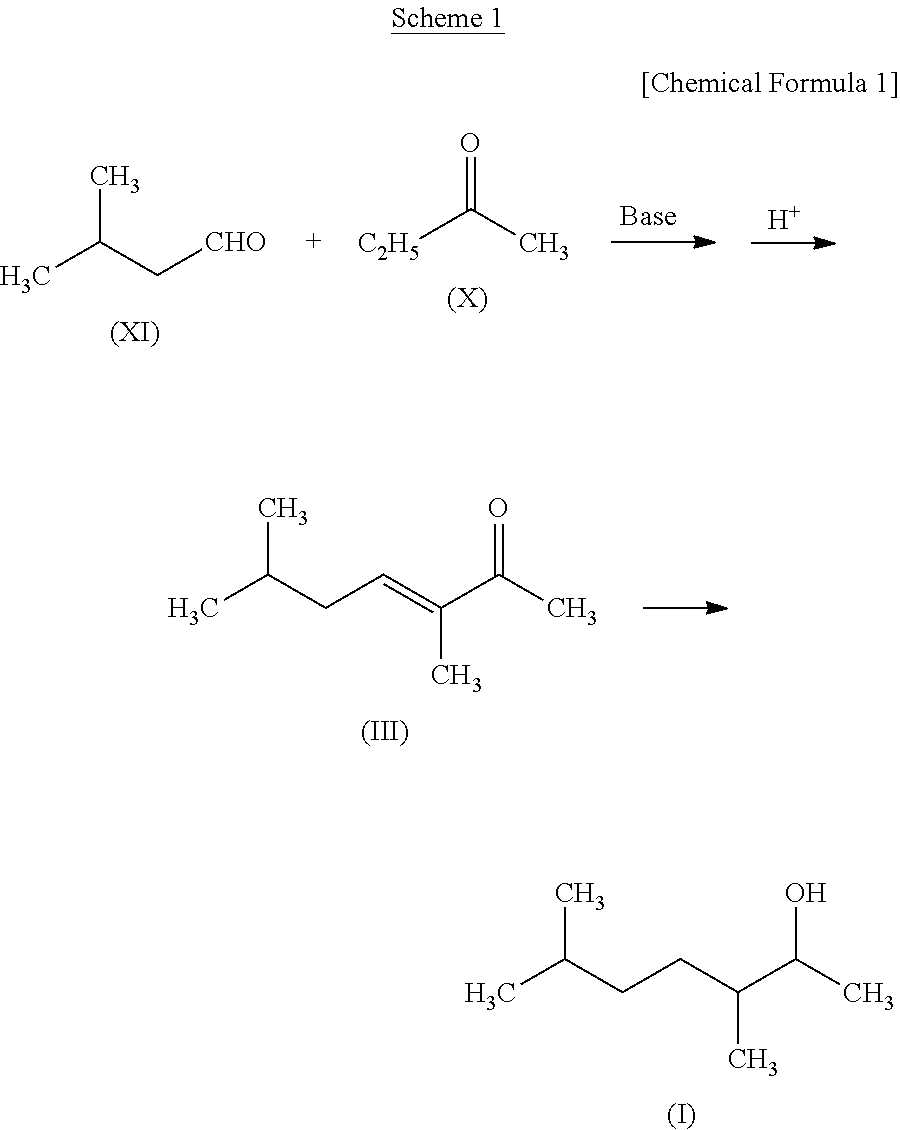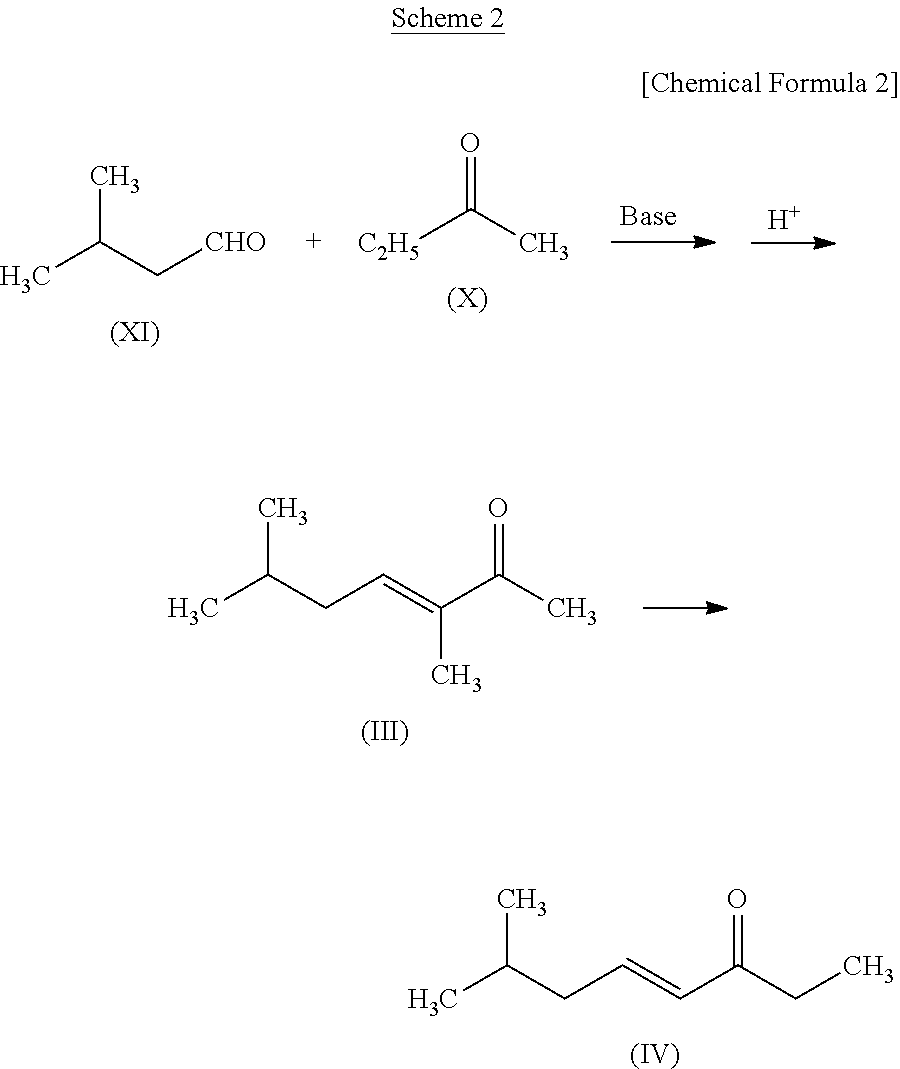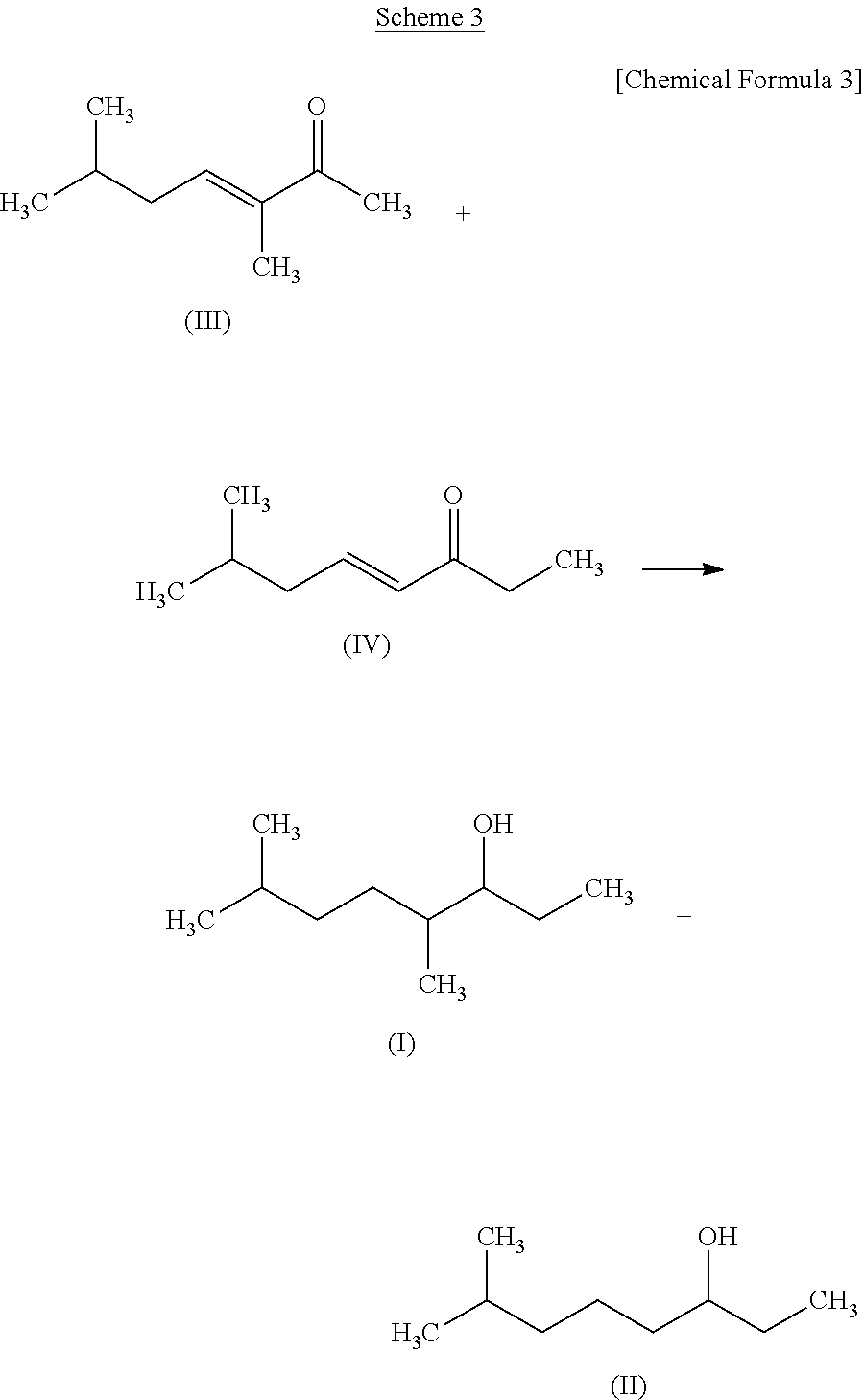Fragrance composition
a technology of dimethyl heptane and composition, which is applied in the direction of biocide, detergent compounding agent, hair cosmetics, etc., can solve the problems of difficult to predict the change of fragrance notes, difficult to predict the harmonicity with other fragrance materials, etc., and achieves excellent harmonicity, strong floral feeling, and good yield
- Summary
- Abstract
- Description
- Claims
- Application Information
AI Technical Summary
Benefits of technology
Problems solved by technology
Method used
Image
Examples
production example 1
Production of 3,6-dimethylhept-3-ene-2-one (Compound (III)) and 7-methyloct-4-en-3-one (Compound (IV))
[0133]
[0134]In a flask, sodium hydroxide (0.1 g), water (20 g), and 2-butanone (X) (42 g, 0.58 mole) were placed and maintained at 15° C., and isovaleraldehyde (XI) (20 g, 0.23 mole) was dropped in five hours while stirring. Then sodium hydroxide (0.2 g) was added thereto additionally, which was further stirred at 25° C. for 48 hours. After stirring, the reaction solution was allowed to stand still and then the lower layer was removed. Thereafter, excess 2-butanone (X) was removed from the upper layer by distillation.
[0135]Subsequently, 85% phosphoric acid (1 g) was added to the upper layer portion of the reaction solution. With a water fractionator being attached to the flask, it was heated to 120° C. to be dehydrated. Sodium hydroxide (0.7 g) was added to the reaction solution thus dehydrated to neutralize it and then magnesium sulfate was added to dry it. Thereafter, the magnesiu...
production example 2
Production of 3,6-dimethylheptane-2-ol (Compound (I))
[0138]
[0139]In a pressure resistant vessel, 5% active carbon supporting ruthenium catalyst (0.3) g, isopropyl alcohol (2.5 g), and Compound (III) (6 g) obtained in Production Example 1 were placed and then were hydrogenated at 90° C. under a hydrogen pressure of 0.5 MPa for 6.5 hours. The reaction solution thus obtained was filtered and thereby 6 g of filtrate was obtained (with a yield of 95%).
[0140]The filtrate thus obtained was concentrated and the concentrated solution thus obtained was purified using a silica gel column (Eluent:Hexane:Ethyl acetate=97:3 (v / v)). The purified product thus obtained was further purified by distillation and thereby 2 g of Compound (I) was obtained. Compound (I) thus obtained had a purity of 100%.
[0141]With respect to Compound (I), measurement results of 1H-NMR and 13C-NMR as well as odor evaluation are shown below.
[0142]1H-NMR (CDCl3, 400 MHz, δ ppm): 0.85-0.92 (m, 9H), 1.02-1.20 (m, 5H), 1.20-1.3...
production example 3
Production of 7-methyloctane-3-ol (Compound (II))
[0144]
[0145]In a pressure resistant vessel, 5% active carbon supporting ruthenium catalyst (0.1 g), isopropyl alcohol (0.6 g), and Compound (IV) (1.5 g) obtained in Production Example 1 were placed and then were hydrogenated at 90° C. under a hydrogen pressure of 0.5 MPa for 22 hours. The reaction solution thus obtained was filtered and thereby 1.4 g of filtrate was obtained (with a yield of 93%).
[0146]The filtrate thus obtained was concentrated and the concentrated solution thus obtained was purified using a silica gel column (Eluent:Hexane:Ethyl acetate=97:3 (v / v)). The purified product thus obtained was further purified by distillation and thereby 1 g of Compound (II) was obtained. Compound (II) thus obtained had a purity of 98.8% (with 1.2% of Compound (I)).
[0147]With respect to Compound (II), measurement results of 1H-NMR and
[0148]13C-NMR as well as odor evaluation are shown below.
[0149]1H-NMR (CDCl3, 400 MHz, δ ppm): 0.88 (d, J=...
PUM
| Property | Measurement | Unit |
|---|---|---|
| temperature | aaaaa | aaaaa |
| temperature | aaaaa | aaaaa |
| temperature | aaaaa | aaaaa |
Abstract
Description
Claims
Application Information
 Login to View More
Login to View More - R&D
- Intellectual Property
- Life Sciences
- Materials
- Tech Scout
- Unparalleled Data Quality
- Higher Quality Content
- 60% Fewer Hallucinations
Browse by: Latest US Patents, China's latest patents, Technical Efficacy Thesaurus, Application Domain, Technology Topic, Popular Technical Reports.
© 2025 PatSnap. All rights reserved.Legal|Privacy policy|Modern Slavery Act Transparency Statement|Sitemap|About US| Contact US: help@patsnap.com



